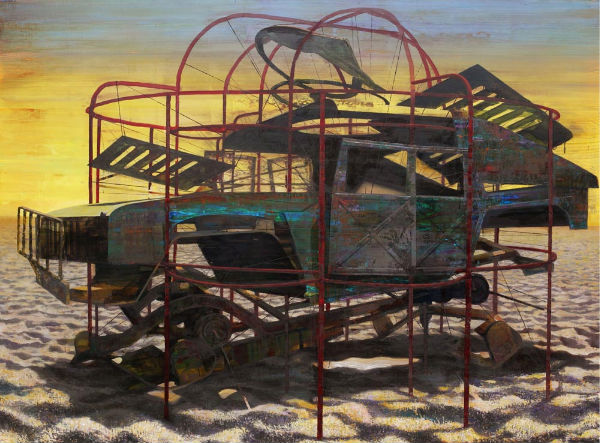Daniel Dove

Many contemporary artists explore the impact that pollution and industry is having on our environment. Oftentimes these paintings depict semi-apocalyptic landscapes, filled with wires and rubbish, or desolate spaces.

In the painting directly above, Prop House, from 2006, Daniel Dove seems to have presaged the crisis we currently find ourselves in with the BP oil spill. Several of Dove’s paintings from 2006 and 2007 have the signs of big oil companies in them, as if these corporate logos are the both the central subjects of the paintings, as well as a mysterious or destructive force.

In Eye of Providence (above), we see the Citgo sign in a semi-abstract, semi-realistic industrial space. It is interesting to ponder that in this subterranean room, one force could be controlling “providence” and the fate of nations.

On a technical level, which also becomes a metaphorical one, I can appreciate how Dove will often blend two separate environments into an abstract whole. For example, in the painting above, entitled Playscape, we see the vibrant playground blending into the equally vibrant graffiti in the background. By presenting a hybrid environment, where one thing overlaps and becomes the other, Dove raises questions in the images he presents us with. What does it imply, when one environment meets and forms with another?

This painting, simply called, Overlap (Version II), offers a more concrete example of the hybrid environment, with the photorealistic background of the brick wall and graffiti merging into the abstract structure of the city playground.

Dove also has several paintings that are like snapshots of crashes, car or plane. What is interesting about the above painting, entitled Autopsy, is that we are presented with the after-effect. Although the painting appears to depict the crash as it is happening, the closed, dense space of the painting seems to tell us otherwise.

In Sequel, we see an almost computerized, abstract environment with the gigantic plane breaking the “glass” of the painting. Again a closed area appears around the top, as if suggesting the density of destruction.





Leave a Reply